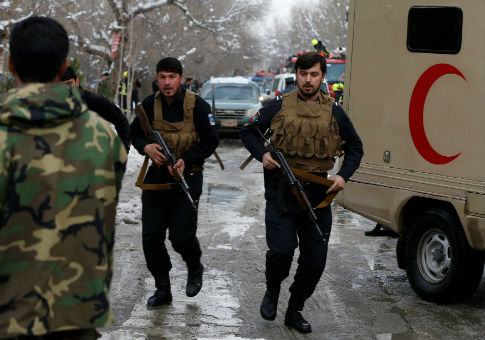By Mirwais Harooni
KABUL (Reuters) – At least 20 people were killed on Tuesday in a bomb blast outside the Supreme Court in the center of the Afghan capital, government officials said, in what appeared to be the latest in a series of attacks on the judiciary.
The Ministry of Public Health said at least 20 people were killed, while 41 wounded were taken to Kabul hospitals.
There was no immediate claim of responsibility for the attack, in which police said an apparent suicide bomber targeted Supreme Court employees leaving their offices at the end of the working day.
"When I heard a bang I rushed toward the Supreme Court's parking lot to find my brother who works there," said witness Dad Khuda, adding that he had found his brother alive.
"Unfortunately, several people were killed and wounded."
Reuters reporters at the scene saw blood stains on the street and ambulances leaving the area.
The bomber appeared to have entered an area where guards were performing security checks when he detonated the explosives.
Afghan President Ashraf Ghani condemned the attack as a "crime against humanity and an unforgivable act."
Courts and Judges Targeted
The Supreme Court was the target of a bomb in June, 2013, when a suicide bomber drove an explosives-packed car into a bus carrying court employees, including judges.
The Taliban claimed responsibility for that attack, and since then security near the court has been increased with large concrete blast walls.
In 2015 a Taliban bomber killed five prosecutors from the Attorney General's office in Kabul, and last year Taliban gunmen stormed a legal office in Logar province, killing seven people, including two prosecutors.
The same militant group killed four people at a provincial courthouse in Ghazni in 2016.
Last month, bombers killed more than 30 people and wounded about 70 in twin blasts in a crowded area of Kabul during the afternoon rush hour.
The Islamist militant Taliban, fighting to oust foreign forces and bring down the U.S.-backed government, claimed responsibility for that Jan. 10 attack.
Afghan government forces control no more than two-thirds of national territory, and have struggled to contain the insurgency since the bulk of NATO soldiers withdrew at the end of 2014.
Several thousand foreign troops, most of them Americans, remain in training and counter-terrorism roles.
